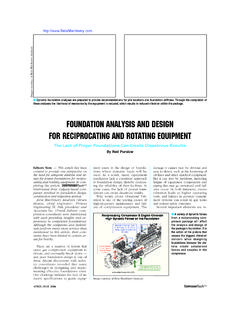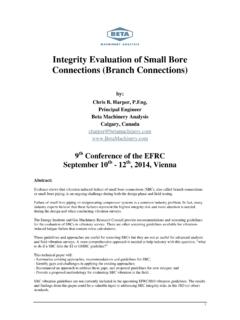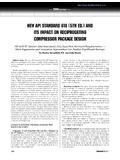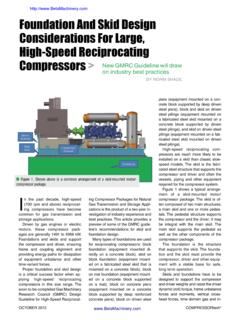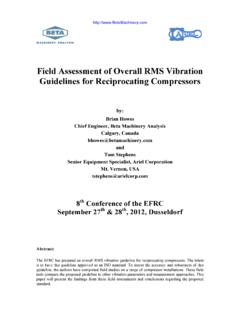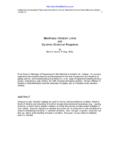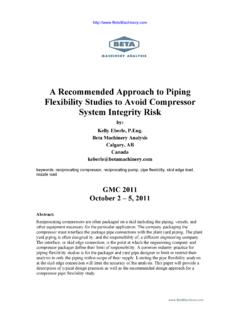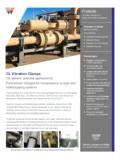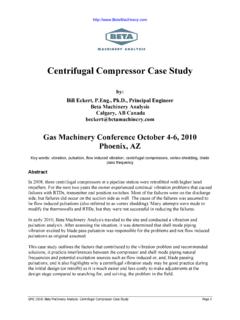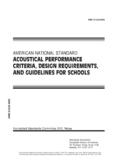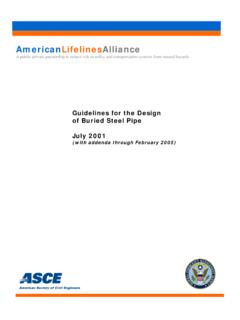Transcription of Design Challenges for Recip Compressors in …
1 Design Challenges for Reciprocating Compressors in Specialty Gas Services by: Kelly Eberle and Michael Cyca engineering Design Beta Machinery Analysis Calgary, AB Canada GMC 2010 October 4 6, 2010 Abstract: Many software tools are used to simulate compressor performance and pressure pulsations in piping systems. Designers of reciprocating equipment rely on these tools to accurately simulate gas properties and pressure pulsations for specialty gases. Two case studies on reciprocating Compressors , involving ethane and ethylene, outline the root causes and consequences of inaccurate performance and pulsation predictions. Both systems experienced many problems after commissioning. Field analysis and subsequent simulation found inaccuracies in compressor performance modeling.
2 This paper outlines a number of Design tips and lessons learned that will be helpful to engineers involved in all reciprocating compressor applications. GMC 2010: Beta Machinery Analysis Design Challenges for Reciprocating Compressors in Specialty Gas Services Page 2 1 Introduction Computer models are used to simulate many different aspects of the operation of reciprocating Compressors . Typical applications of computer models include simulating the compressor performance, torsional and lateral responses, deflection and stress in the skid beams due to lifting, dynamic response of the compressor cylinders, bottles and piping, and thermal expansion of the piping. Modeling of the compressor systems requires representing the physical properties of the compressor , vessels, piping and gas.
3 The physical properties of the compressor , vessels, and piping are well defined. The physical properties of the gas are determined by testing and thermodynamic theory. Many different mathematical models exist for calculating gas properties. Each of these models has various strengths and weaknesses in terms of the accuracy with which they represent the gas physical properties. Mathematical models have been developed, which are well known and have been proven to accurately simulate common gases such as natural gas in pipeline applications. Compressors operating in a refinery or manufacturing facility are often used in applications where the gases are unique and simulation of the physical properties is not well understood.
4 These specialty gases require proper selection of the model techniques to ensure that the results from the simulations result in a safe and reliable Design . Case studies will be presented to show the impact of incorrect modeling of gas properties. In the first case study, compressor performance simulation of an ethane service by many programs produce erroneous results. The second case study shows how inaccurate simulation of pressure pulsations leads to excessive vibrations on the compressor . Before discussing these case studies in detail, some background on compressor performance modeling, calculating gas properties, and pressure pulsation analysis in these applications is necessary. 2 Background compressor Performance Simulation and Equations of State Simulating or modeling the performance of a reciprocating compressor involves calculating the expected flow, power consumption, discharge temperature, etc.
5 , based on the compressor geometry and operating information. The operating information typically includes inlet pressure, discharge pressure, inlet temperature, and gas composition. The gas composition and operating data is used to calculate thermodynamic properties of the gas; these properties are then used in the performance calculation. For example the adiabatic discharge temperature for the gas that is being compressed, TD, can be calculated from the following equation. =kkSDRTT1 where ST = suction temperature (absolute) R = compression ratio (absolute discharge pressure divided by absolute suction pressure) k = ratio of specific heats GMC 2010: Beta Machinery Analysis Design Challenges for Reciprocating Compressors in Specialty Gas Services Page 3 The ratio of specific heats is a physical, or thermodynamic characteristic, of the gas.
6 There is no theoretical means of calculating characteristics such as the ratio of specific heats for gases. Typically, experimentation is done to determine these properties at a few temperatures and pressures and then models or equations of state (EoS) are derived. These equations of state can then be used to calculate the thermodynamic properties of gases for a range of pressures and temperatures. Many EoS have been developed, such as Van der Waals, Redlich-Kwong, Peng Robinson, Berthelot and Dieterici to name a few. All EoS have pressure and temperature ranges and gas mixtures where they are more accurate than others, so care must be taken to properly select the appropriate equation for the particular application.
7 Another factor that is important in the calculation of the gas properties is determining where the particular operating point is relative to the critical point. The critical point, also called a critical state, specifies the conditions (temperature and pressure) at which a phase boundary ceases to exist. It is extremely difficult to obtain the fluid properties at, or around, the critical point experimentally, or from EoS models. The other region where an EoS is inaccurate is at very high pressure, both above and below critical temperature, unless careful modifications to the EoS are made, as will be demonstrated later in a case study. The image shown in Figure 1 is a representative pressure-temperature phase diagram for water.
8 The calculation of the gas properties is relatively simple for a gas when the process remains within the gaseous phase and below the critical temperature and pressure. In some cases the gas process transitions from one area of the phase diagram to another requiring a more robust model of the gas properties. Figure 1: Typical Phase Diagram The discharge temperature was cited earlier as one output from the compressor performance simulation that is dependent on accurate calculation of the gas properties. Other compressor performance results, such as, volumetric efficiency, flow, and power are dependent upon gas properties, such as, the compressibility, ratio of specific heats, polytropic exponent, viscosity, and specific gravity.
9 Accurate calculation of these gas properties is key to accurate calculation of the compressor performance. GMC 2010: Beta Machinery Analysis Design Challenges for Reciprocating Compressors in Specialty Gas Services Page 4 Pressure Pulsation Simulation Gas Properties The previous section described the importance of accurately simulating the gas properties when calculating compressor performance. Similarly, simulating pressure pulsations generated by reciprocating Compressors involves many of the same aspects of simulating gas properties. One key parameter in the understanding of pressure pulsations in a reciprocating compressor system is the acoustic velocity, or speed of sound in the gas.
10 The acoustic velocity, c, can be calculated using the following equation. ()() = =SGZTkcSGZTkc where k = ratio of specific heats T = absolute temperature ( K, or R) Z = compressibility SG = specific gravity The acoustic velocity in the gas is one of the most fundamental and critical characteristics calculated for a pulsation analysis. Other acoustical characteristics are also dependent on the gas properties. Accurate calculation of gas properties is key for an accurate pulsation analysis. Note that the equations referenced above are simplified assuming the gas properties are constant with time. The fluctuating pressure and temperature in reciprocating Compressors means the gas properties will also be time dependent.
